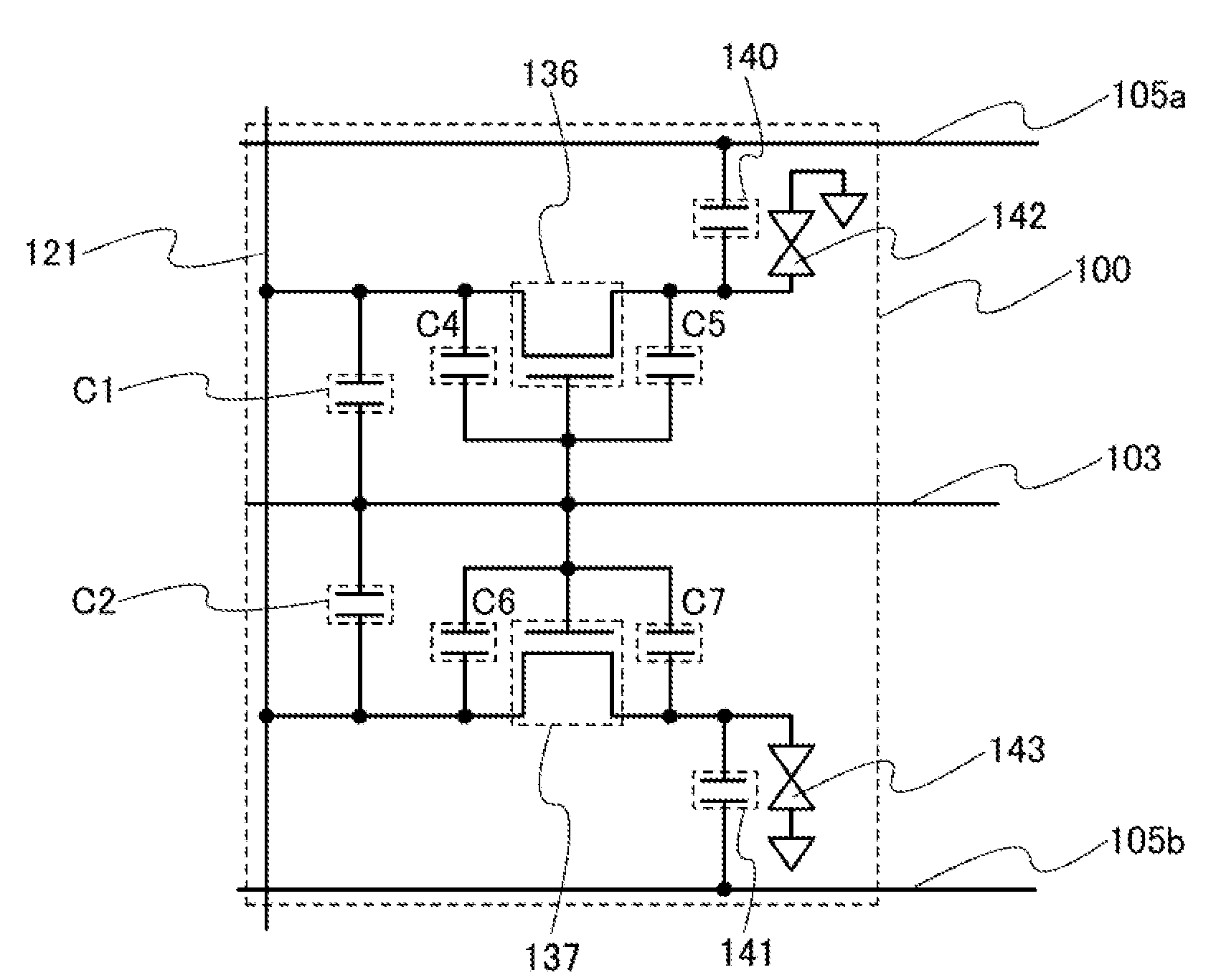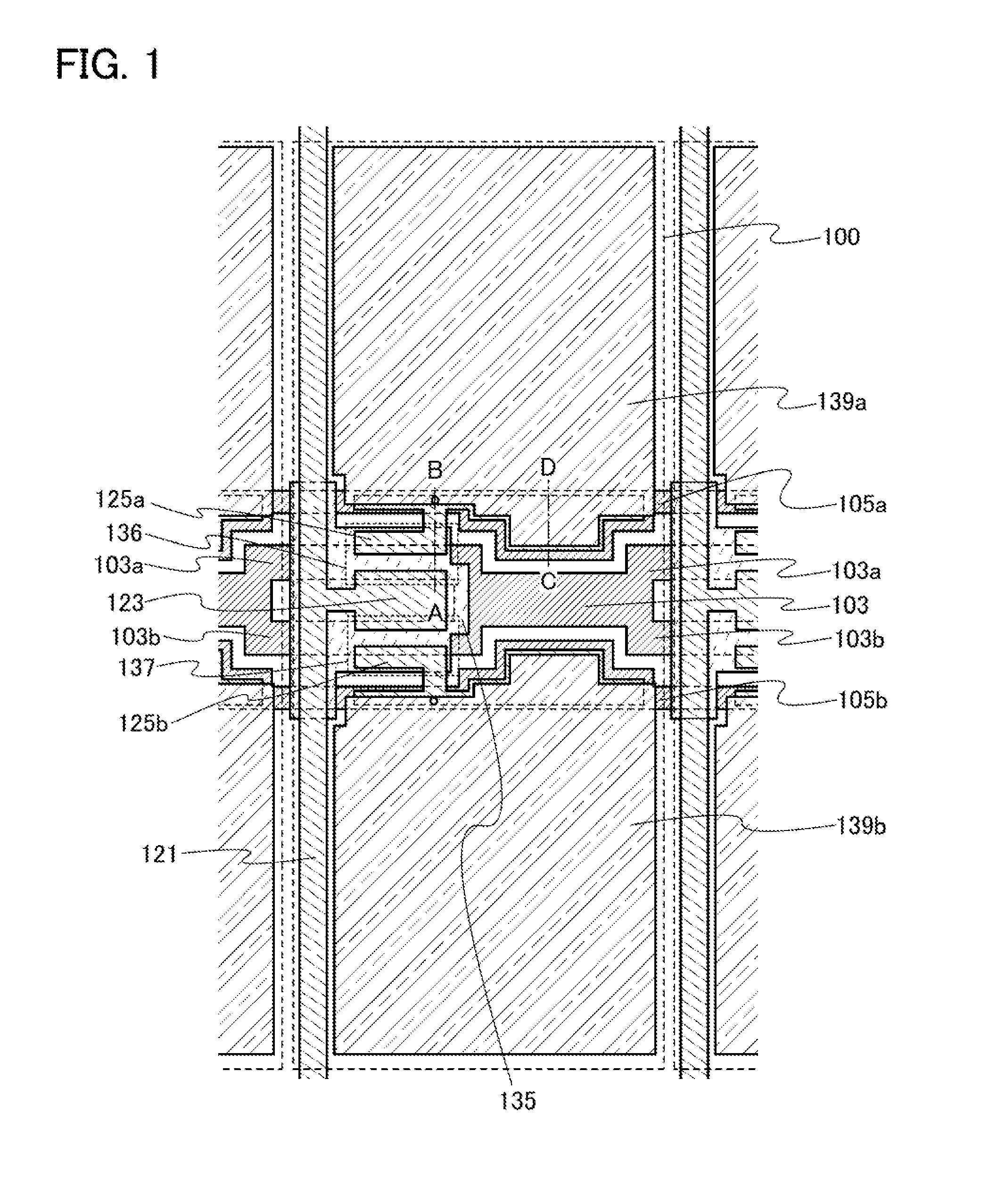Display device
a display device and display technology, applied in static indicating devices, instruments, optics, etc., can solve the problems of deteriorating display quality, increased power consumption, and delay in signal transmission to the end portion of a signal line, so as to reduce parasitic capacitance between the scan line and the first electrode, the effect of reducing the aperture ratio of a pixel
- Summary
- Abstract
- Description
- Claims
- Application Information
AI Technical Summary
Benefits of technology
Problems solved by technology
Method used
Image
Examples
embodiment 1
[0029]In this embodiment, a structure of a pixel of a liquid crystal display device in which wiring capacitance is reduced will be described with reference to FIG. 1, FIGS. 2A and 2B, FIGS. 3A and 3B, and FIGS. 8A to 8C. Note that a pixel in which one pixel is provided with a plurality of subpixels is described as a pixel 100 in this embodiment; however, one embodiment of the present invention is not limited thereto.
[0030]FIG. 1 is a top view of the pixel 100 of a multi-domain liquid crystal display device, which is described in this embodiment. FIG. 2A is a circuit diagram of the pixel 100 in FIG. 1. FIG. 2B is a circuit diagram of a conventional pixel. FIG. 3A is a cross-sectional view taken along dashed-and-dotted line A-B in FIG. 1. FIG. 3B is a cross-sectional view taken alone dashed-and-dotted line C-D in FIG. 1. FIG. 8A is an enlarged top view of the vicinity of a thin film transistor 136 and a thin film transistor 137 in FIG. 1. FIG. 8B is a top view illustrating only a scan...
embodiment 2
[0085]In this embodiment, a structure of a pixel, which has a structure different from that in Embodiment 1, of a liquid crystal display device whose wiring capacitance is reduced will be described with reference to FIG. 4 and FIG. 5. Note that a pixel in which one pixel is provided with a plurality of subpixels is described as a pixel 150 in this embodiment; however one embodiment of the present invention is not limited thereto.
[0086]FIG. 4 is a top view of the pixel 150 of a multi-domain liquid crystal display device, which is described in this embodiment, and FIG. 5 is a cross-sectional view taken along dashed-and-dotted line E-F in FIG. 4.
[0087]As illustrated in FIG. 4, the pixel 150 includes the scan line 103; a signal line 151 which intersects with the scan line 103; and the capacitor wiring 105a and the capacitor wiring 105b which extend in the same direction as the scan line 103. The scan line 103 is provided between the capacitor wiring 105a and the capacitor wiring 105b.
[...
embodiment 3
[0112]In this embodiment, a method for manufacturing the thin film transistors described in Embodiments 1 and 2 will be described with reference to FIGS. 6A to 6D and FIGS. 7A and 7B. A method for manufacturing the thin film transistor 136 in Embodiment 1 is described here; however, the method can be applied to the thin film transistor 137 in Embodiment 1 and the thin film transistors 166 and 167 in Embodiment 2 as appropriate. Note that an n-channel thin film transistor has higher carrier mobility than a p-channel thin film transistor. Further, it is preferable that all thin film transistors formed over the same substrate have the same polarity because the number of manufacturing steps can be reduced. Therefore, in this embodiment, a method for manufacturing an n-channel thin film transistor is described.
[0113]As illustrated in FIG. 6A, the scan line 103 is formed over the substrate 101. Next, the gate insulating film 107 which covers the scan line 103 is formed, and a microcrystal...
PUM
 Login to View More
Login to View More Abstract
Description
Claims
Application Information
 Login to View More
Login to View More - R&D
- Intellectual Property
- Life Sciences
- Materials
- Tech Scout
- Unparalleled Data Quality
- Higher Quality Content
- 60% Fewer Hallucinations
Browse by: Latest US Patents, China's latest patents, Technical Efficacy Thesaurus, Application Domain, Technology Topic, Popular Technical Reports.
© 2025 PatSnap. All rights reserved.Legal|Privacy policy|Modern Slavery Act Transparency Statement|Sitemap|About US| Contact US: help@patsnap.com



